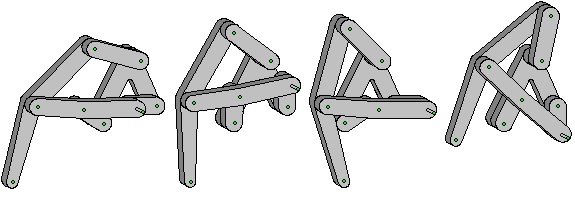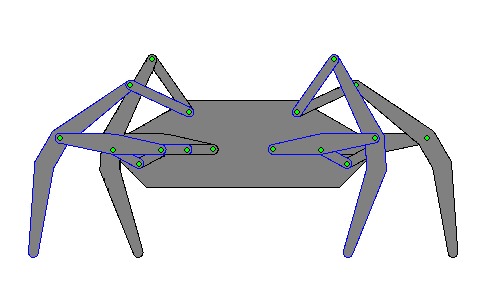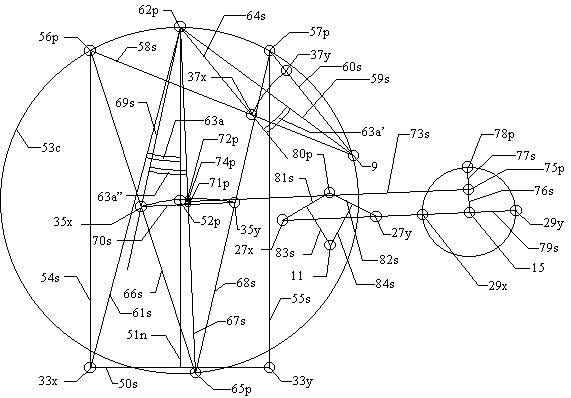
Klann Linkage
Encyclopedia
The Klann linkage is a planar mechanism designed to simulate the gait of legged animal and function as a wheel replacement. The linkage consists of the frame
, a crank
, two grounded rockers, and two couplers all connected by pivot joints.
The proportions of each of the links in the mechanism are defined to optimize the linearity of the foot for one-half of the rotation of the crank. The remaining rotation of the crank allows the foot to be raised to a predetermined height before returning to the starting position and repeating the cycle. Two of these linkages coupled together at the crank and one-half cycle out of phase with each other will allow the frame of a vehicle to travel parallel to the ground.
The Klann linkage provides many of the benefits of more advanced walking vehicles without some of their limitations. It can step over curbs, climb stairs, or travel into areas that are currently not accessible with wheels but does not require microprocessor control or multitudes of actuator mechanisms. It fits into the technological space between these walking devices and axle-driven wheels.



which are used to develop four-bar double-rocker linkages such as harbor crane booms. It is categorized as a modified Stephenson type III kinematic chain.
Frame
A frame is a structural system that supports other components of a physical construction.Frame may also refer to:-Engineering & construction:* A-Frame, a basic structure designed to bear a load in a lightweight economical manner...
, a crank
Crank (mechanism)
A crank is an arm attached at right angles to a rotating shaft by which reciprocating motion is imparted to or received from the shaft. It is used to change circular into reciprocating motion, or reciprocating into circular motion. The arm may be a bent portion of the shaft, or a separate arm...
, two grounded rockers, and two couplers all connected by pivot joints.
The proportions of each of the links in the mechanism are defined to optimize the linearity of the foot for one-half of the rotation of the crank. The remaining rotation of the crank allows the foot to be raised to a predetermined height before returning to the starting position and repeating the cycle. Two of these linkages coupled together at the crank and one-half cycle out of phase with each other will allow the frame of a vehicle to travel parallel to the ground.
The Klann linkage provides many of the benefits of more advanced walking vehicles without some of their limitations. It can step over curbs, climb stairs, or travel into areas that are currently not accessible with wheels but does not require microprocessor control or multitudes of actuator mechanisms. It fits into the technological space between these walking devices and axle-driven wheels.
Illustrations



History
The Klann linkage was developed by Joe Klann in 1994 as an expansion of Burmester curvesBurmester's theory
Burmester's theory is named after Ludwig Burmester . Burmester introduced geometric techniques for synthesis of linkages in the late 19th century. His approach was to compute the geometric constraints of the linkage directly from the inventor's desired movement for a floating link...
which are used to develop four-bar double-rocker linkages such as harbor crane booms. It is categorized as a modified Stephenson type III kinematic chain.
- U.S. Provisional Application Ser. No. 60/074,425, was filed on Feb. 11, 1998
- US Patent 6,260,862 , issued July 17, 2001
- US Patent 6,364,040 , issued April 2, 2002
- US Patent 6,478,314 , issued November 12, 2002

